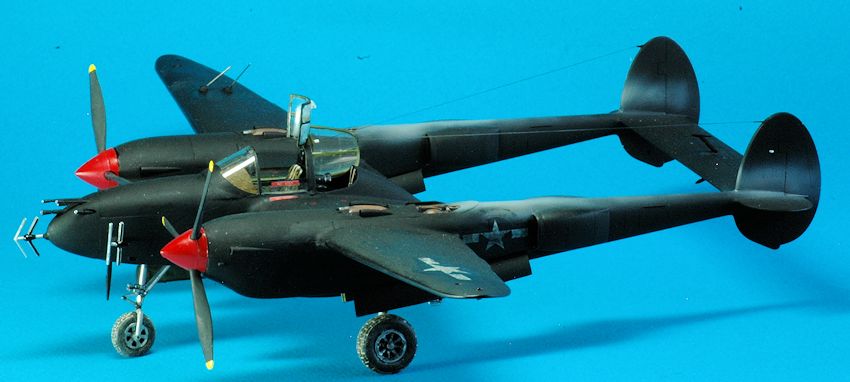
Hasegawa 1/48 P-38G w/YAGI radar
| KIT #: | 09103 |
| PRICE: | $29.99 when new |
| DECALS: | Three options |
| REVIEWER: | Andrew Garcia |
| NOTES: | Conversion using AMT P-70 kit parts |

| HISTORY |
The P-38 Lighting was a twin engine prop-driven aircraft from the WWII era. It was a successful combat aircraft serving in all theaters with distinction in the fighter, bombing, and reconnaissance roles. In July of 1938 sub-assembly production commenced and on January 27, 1939 it flew on its maiden flight. America’s top Ace, Richard Ira Bong, was among many aces who flew and won with the P-38.
Although shining black P-38M two-seaters of 1945 have always been considered the
sole night fighter of the Lightning series, radar-equipped versions of the P-38F
or P-38G fought the Japanese in the Pacific at Guadalcanal and in New Guinea as
early as February 1943. Wings magazine, Vol. 8 No. 4, August 1978 on page 21,
has two photos, # 6 & 7, of the field conversion of early Lightning’s into radar
night fighters. They call the photos “A Rara Avis Supreme”
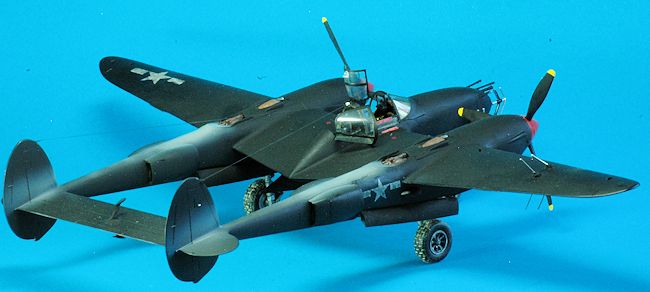 indicating
the photos and these modified aircraft were real rarities. I had no knowledge of
this modification before reading this and never heard about it again until the
book “Queen of the Midnight Skies” was published in 1992. I hoped that one day I
would be able to create one of these rarities in 1/48th scale. Wings Magazine
calls them modified P-38F’s and Queen of the Midnight Skies calls them P-38G’s
on page 69-70.
indicating
the photos and these modified aircraft were real rarities. I had no knowledge of
this modification before reading this and never heard about it again until the
book “Queen of the Midnight Skies” was published in 1992. I hoped that one day I
would be able to create one of these rarities in 1/48th scale. Wings Magazine
calls them modified P-38F’s and Queen of the Midnight Skies calls them P-38G’s
on page 69-70.
Externally the P-38F and P-38G are
nearly identical. The modeling complication of this project is the P-38F in the
early production block had side opening canopy top center sections and the P-38G
had the later hinged to the rear opening canopy. Also, the early P-38F had no ID
lights under the fuselage but the P-38G does use the three fuselage underside ID
lights. There are intercooler air intakes located on the leading edge of the
wing outboard from the engine nacelle but not represented in the Hasegawa kit.
The intercooler exhaust is located on the top of each wingtip and is missing
from the Hasegawa kit. This is a very small opening as evidenced by the very
clear P-38 Glacier Girl “walk around” and re-construction detail photos
available on the web.
| THE KIT |
A great intro and one that I started my project with for this kit comes from the Modeling Madness archives in 1996 and can be found here. Hasegawa released its P-38 series in July 1993, first in the P-38J variant and later in a P-38F/G/H variant with most of the appropriate changes to the airframe. The mouldings hold up well and a very nice early P-38 can be built from this kit. Although not one of the easiest of WWII aircraft to build anyone with some modeling experience will be rewarded with a fine replica if you take your time and apply some filler and test fitting of parts before committing them to assembly with glue.
Hasegawa’s 1/48 scale P-38G/F/H Lighting is comprised of 110 grey plastic parts on 15 sprues, plus a small metallic self-adhesive disk aiding the modeler to incorporate the distinctive feature of a polished circle on the lower inside of the engine boom. This polished NMF disk was used on the actual aircraft to confirm landing gear status by a visual cue. This release has markings for three early P-38 schemes.
 Panel line
detail on the fuselage is crisp and fine. A few places have incomplete panel
lines such as the engine boom connection to the wing area but it is not very
noticeable unless you are tracing every panel line. The cockpit is complete and
accurate with sufficient detail for most modelers. A robust aftermarket has
provided many resin cockpit alternatives or etched enhancements.
Panel line
detail on the fuselage is crisp and fine. A few places have incomplete panel
lines such as the engine boom connection to the wing area but it is not very
noticeable unless you are tracing every panel line. The cockpit is complete and
accurate with sufficient detail for most modelers. A robust aftermarket has
provided many resin cockpit alternatives or etched enhancements.
Care is required in construction due to the many variants of the lightning and the multiple adaptations of the Hasegawa kit plastic in its representation of several P-38 variants. Subtle changes such as the landing light, which had three variations for example, are captured in the base plastic kit. You have to be aware of the changes by variant, opening the required kit plastic orifices to accurately show the correct landing light configuration, for example, with the version you wish to model. Hasegawa does a good job of indicating the changes in its well-done instructions. This approach has permitted them to make multiple versions and re-boxing’s using a small variation in parts trees. It is the only P-38 kit in this scale that has the proper upturned wing tips.
Cockpit detail is very good and can be enhanced by the addition of colour and brass photo-etched parts or totally replaced by several resin sets available at this time. There is no engine but several aftermarket engines can be used with this kit. A Verlinden detail set provides an open engine and nose armament section. The wheel wells are basic and adequately represent this area for all but the die-hard modeler who includes this area in the important to detail modeling requirements.
The purpose of this build is to show its conversion into a P-38G with a field modified SCR-540 Yagi radar addition. The radar was taken from a P-70, both with the actual aircraft and with the plastic model build.
| RESEARCH |
I converted the Hasegawa P-38F/G/H into a P-38G which was converted in the field to a Night Fighter as a field modification with the addition of YAGI radar and a second seat in the rear of the P-38G. The project took shape while I was searching for information for another P-38 conversion. I came across several photographs and text explanations of what the text called a P-38F or P-38G “night fighter radar field modification” using the SCR540 Radar components taken from a P-70 night fighter.
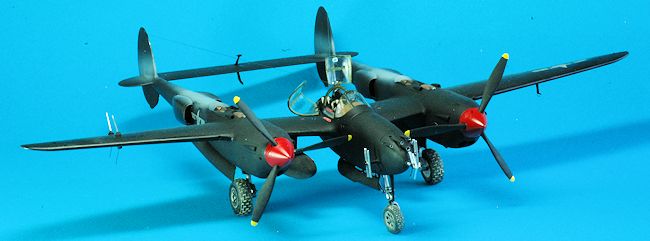 An
additional complication is getting a definitive answer on the aircrew used in
these modified P-38’s. Was it a single pilot and no crew or was there an
additional person in a rear seat operating the radar similar to what we saw in
the later P-38M Night Fighter? If it was a two person airframe was the rear
canopy separate and opened as did the P-38M? Did it open to the side as in the
early P-38’s or to the rear as in the P-38G and later P-38’s? Since I could not
find any photos from above the wings of the whole aircraft to resolve the issue
of which wing side, port or starboard, to use for the YAGI radar array wing
mounted antennas was a concern. The radar components were taken from a P-70. The
P-70 has the YAGI radar array on the left (port) wing. However, the Owl kit
places the YAGI wing di-poles on the right (starboard) wing for its PV-1
conversion kit and the photo, # 7 in Wings Magazine reference photo shows the
poles mounted above and below the right wing so I used the right wing side for
mounting these antennas.
An
additional complication is getting a definitive answer on the aircrew used in
these modified P-38’s. Was it a single pilot and no crew or was there an
additional person in a rear seat operating the radar similar to what we saw in
the later P-38M Night Fighter? If it was a two person airframe was the rear
canopy separate and opened as did the P-38M? Did it open to the side as in the
early P-38’s or to the rear as in the P-38G and later P-38’s? Since I could not
find any photos from above the wings of the whole aircraft to resolve the issue
of which wing side, port or starboard, to use for the YAGI radar array wing
mounted antennas was a concern. The radar components were taken from a P-70. The
P-70 has the YAGI radar array on the left (port) wing. However, the Owl kit
places the YAGI wing di-poles on the right (starboard) wing for its PV-1
conversion kit and the photo, # 7 in Wings Magazine reference photo shows the
poles mounted above and below the right wing so I used the right wing side for
mounting these antennas.
Based on the Wings magazine narrative, incomplete records indicate that these modified P-38F aircraft were limited to a total of two, both being converted at Port Moresby or in Australia in January 1943. Assigned to the 6th Night Fighter Squadron with other P-38F’s and “G”’s as well as some Douglas P-70’s, they operated with the VII th Air Force in the 18th Fighter Group. However, at least some records indicate that they may have operated as Detachment A with the 8th Fighter Squadron of the famed 49th Fighter Group. Another P-38 detachment of the 6th NFS operated with the XIII th AF at Guadalcanal at about the same time. The squadron insignia, official from 1924, was a skull on a spinning propeller background.
Field
rework of the two night fighters was an extremely inventive and complex project,
evidently designed and executed by the squadron engineering officer and one
armament/radio mechanic. P-70 Yagi type antennas were fitted to the nose
section, and a SCR-540 radar set was installed. Two of the 50-caliber machine
guns were relocated forward (a very difficult task). The P-38’s were sprayed
dull black overall. When these pictures were taken, the aircraft may have become
assets of the 418th NFS at Dobodura in the First Air Task Force. From another
account I found “Early in 1943, at least two unidentified P-38Gs were modified
in the field by the Fifth Air Force as single-seat night fighters by fitting an
SCR540 radar wi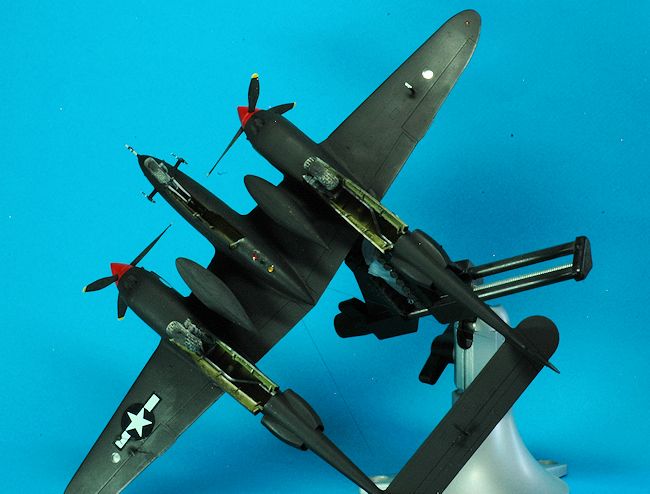 th
Yagi antennae on the nose and antennas on both sides of the central nacelle, and
above and below the wings. In order to make room for the radar, two of the
0.50-inch machine guns and their ammunition boxes had to be moved forward.”
th
Yagi antennae on the nose and antennas on both sides of the central nacelle, and
above and below the wings. In order to make room for the radar, two of the
0.50-inch machine guns and their ammunition boxes had to be moved forward.”
Other accounts (which are suspect) in web musings may be a combination of information poorly described because there were two Yagi field mod aircraft and several other P-38’s in the same unit used as night fighters but without internal radar relying on ground controller vectoring and searchlights. In order to provide a balanced view these were the comments I found: “However, these modifications were all single seat aircraft, and it was found that the flying of the plane and the operation of the radar was too much of a job for just one person. Consequently, Lockheed attempted to adapt the P-38L as a two-seat night fighter. In 1944, Lockheed converted P-83L-5-LO Serial Number 44-25237 into a two-seat night fighter, with the radar operator sitting aft of the pilot under a raised section of the canopy. The aircraft was fitted with an AN/APS-6 radar in an external radome underneath the nose, and relocated the radio equipment and added anti-flash gun muzzles.”
From a modelers perspective some additional airframe details need to be kept in mind. Based on my reading and research I made the following conversion assumptions. The airframe was a P-38G and was a two-seater with a second seat in the rear. The Yagi radar provided a very small display that could be inserted into the small rear compartment instrument panel. The radio that normally occupied that space was re-located to one of the drop tanks. Nothing definitive on how the rear antenna wires that were normally connected to the top of the main canopy hood were re-attached or relocated. The exact configuration of the second canopy hood was not found. Did it open to the side as in early P-38’s or to the rear as in the P-38G and later Lightning’s? Since it was a field modification and no clear parts reconstruction capability existed to create new Plexiglas parts (this component was provided by Rohm & Haas Chemical in Philadelphia), a P-38M type of raised hump glass dome was not attempted. I assumed they cut the rear canopy away from the metal support brace and could in the field create a new aluminum front frame for the second R/O canopy and add a hinge to the side from spare parts taken from older P-38’s using the side hinged canopy attachment with the existing cramped rear Plexiglas canopy. The antenna wire would not have to be relocated due to the side opening. This would also avoid the clearance problem presented by a rear hinged solution. The SRC-552-A antenna mast appeared on the bottom of the nose of the P-38F/G/H and was supplemented with twin radio aerials from the cockpit canopy to the twin tails. This was kept in the field mod version.
My model is based on multiple historical photographic references and sometimes conflicting text or photo captions. The photos are small and of poor quality for really good detail use. The photos I found do not show the aircraft from every angle. Both books and web based references were found. The specific P-38G YAGI radar Field Mod references were:
Reference Text: Queen of the Midnight Skies, Garry Pape & Ronald Harrison, Schiffer Books, 1992 ISBN 0-88740-415-4
In
Chapter 4, Winds Execute, pages 56 to 73, it has information on the defense of
Hawaii after Pearl Harbor and the units movements to Australia, Papua New Guinea
(Port Moresby) and the details on the P-38G conversion. The history of the 6th
NFS with its initial P-70’s is the main story in this chapter. Their initial
combat deployment was to Guadalcanal. The two P-38’s may be some aircraft
transferred at Guadalcanal.
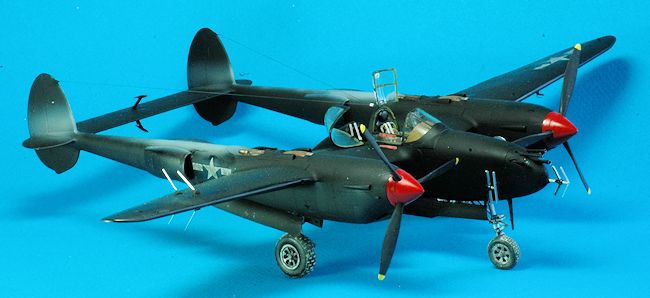 The P-38F or
“G’s” may have been previously seen as P-38F/G White # 138 Old Ironsides (see on
a web photo page with white or light gray prop hubs and White 144 with four
Japanese kill markings and one boat kill marking). In its photo it does not have
any Yagi radar antennas so it was probably one of the “standard” P-38’s. They
were located at 3-Mile Strip, which was called that because it was three miles
from Port Moresby. There is some information on the use of standard P-38’s
teamed with P-70’s using GCI (Ground Control Intercept) radar, and searchlights
for night interceptions. The text on page 69 states “Equipment: A standard P-38G
was used in these missions, the only special equipment was the above mentioned
red cellophane (covering the gun sight light). … September 16, 1943 marked the
end of Guadalcanal Detachment as elements of the 6th NFS. This unit, originally
designated as “Project X”, was now to be independent of 6th Night Fighter
Squadron and designated Detachment “B” Night Fighter Squadron and assigned as an
independent unit of the 13th Air Force. … At 2400 on December 15, 1943,
Detachment “B” Night Fighter Squadrons were disbanded. Some personnel and
equipment on Guadalcanal were transferred to the newly arrived 419th NFS. Other
Detachment members were assigned to different units in their area and a few
returned to Hawaii and the 6th NFS.”
The P-38F or
“G’s” may have been previously seen as P-38F/G White # 138 Old Ironsides (see on
a web photo page with white or light gray prop hubs and White 144 with four
Japanese kill markings and one boat kill marking). In its photo it does not have
any Yagi radar antennas so it was probably one of the “standard” P-38’s. They
were located at 3-Mile Strip, which was called that because it was three miles
from Port Moresby. There is some information on the use of standard P-38’s
teamed with P-70’s using GCI (Ground Control Intercept) radar, and searchlights
for night interceptions. The text on page 69 states “Equipment: A standard P-38G
was used in these missions, the only special equipment was the above mentioned
red cellophane (covering the gun sight light). … September 16, 1943 marked the
end of Guadalcanal Detachment as elements of the 6th NFS. This unit, originally
designated as “Project X”, was now to be independent of 6th Night Fighter
Squadron and designated Detachment “B” Night Fighter Squadron and assigned as an
independent unit of the 13th Air Force. … At 2400 on December 15, 1943,
Detachment “B” Night Fighter Squadrons were disbanded. Some personnel and
equipment on Guadalcanal were transferred to the newly arrived 419th NFS. Other
Detachment members were assigned to different units in their area and a few
returned to Hawaii and the 6th NFS.”
On page 70 two photos of a P-38 identified as a P-38G with Yagi Antenna and SCR-540 radar are shown. The photos were provided courtesy of Carl Hale. Carl was an R/O in P-70’s with the 6th NFS second detachment. His P-70 pilot was Fred Secord. Their destination was “Three-mile” strip (Kila) in New Guinea near Port Moresby.
I found on page 73 some very specific text on this subject: “By October 1943, out of frustration, the unit began experimenting with the idea of converting a P-38 into a night fighter. A P-38G was appropriated and Lt. Melvin Richardson, one of the pilots and the squadrons engineering officer, went to work on it. A SCR-540 AI radar set, probably removed from one of the P-70’s, along with the HF and VHF radios were installed in a belly tank. A second seat was added behind the pilot and the radio sets were wired to the pilots and R/O’s location as well as a scope for the R/O. It was found that even with the additional weight the P-38 could climb to the same altitude as the P-70 in about 10 minutes versus 45 for the P-70. It was capable of greater altitudes than the P-70. A second P-38G Lightning was also modified. For this gallant effort, Lt. Melvin Richardson and a radar mechanic who assisted received the Legion of Merit award.
Testing
of  these
new night fighter aircraft had only just begun when an advanced element of the
newly arrived 418th NFS arrived at Dobodura on November 15, 1943. Detachment “A”
Night Fighter Squadron was disbanded. Some personnel were sent back to the
States while the remainder were scattered among other organizations within Fifth
Air Force.” From this I confirmed it was a two seater with a backseat R/O in a
converted P-38G. The “belly tank” part of the story is confusing. Was this a
term for the drop tanks since the P-38 fuel tanks were in the wings? A look at
the P-38G Tech Order Manual on page 13 Fuel System confirms there was no
internal “belly tank”, only the wing tanks and droppable external tanks hung
under the wings and not the “belly”. The term was probably relating to an
external drop tank which were often called “belly tanks”. Thus, some radio
equipment was probably installed in a non-droppable external tank.
these
new night fighter aircraft had only just begun when an advanced element of the
newly arrived 418th NFS arrived at Dobodura on November 15, 1943. Detachment “A”
Night Fighter Squadron was disbanded. Some personnel were sent back to the
States while the remainder were scattered among other organizations within Fifth
Air Force.” From this I confirmed it was a two seater with a backseat R/O in a
converted P-38G. The “belly tank” part of the story is confusing. Was this a
term for the drop tanks since the P-38 fuel tanks were in the wings? A look at
the P-38G Tech Order Manual on page 13 Fuel System confirms there was no
internal “belly tank”, only the wing tanks and droppable external tanks hung
under the wings and not the “belly”. The term was probably relating to an
external drop tank which were often called “belly tanks”. Thus, some radio
equipment was probably installed in a non-droppable external tank.
On page 107 there is a photo of a P-38 with the caption “In December 1943 the 419th NFS arrived in Guadalcanal and relieved detachment “B” NFS. Captain Al Lukas is pictured in the cockpit of one of the P-38’s that the 419th inherited. Photo courtesy of Al Lukas.” No Yagi antennas are visible on this airframe. The text notes the initial equipment of the 421st NFS were P-38’s. On page 108 there is information that the 419th NFS when it arrived in Dobodura received five P-70’s and two modified P-38G “Night Fighters” of Detachment “A” Night Fighter Squadron. An additional four P-38J’s were received from the 10th Service Squadron but later taken away in January 1944 and replaced with war weary P-38F’s & G’s. By the end of January their aircraft strength stood at ten P-70’s and six P-38’s all of which should have been retired from service long ago. Some pilots mentioned as flying the regular, non-radar equipped, P-38F/G fighters were Col. Carroll C. Smith, Lt. Harold B. Wittern, Lt. Sorbo, Lt. Richard B. Ferris, Lt. Edward E. Craig. In mid-March 1944 the 418th moved to Finschhafen as their new base of operations.
Page 108 again gave me the reason to use the P-38G for the “YAGI Field Mod”. Based on this sentence, “ The 421st did not have a monopoly on this lack of adequate aircraft situation. When the 418th Night Fighter Squadron arrived at Dobodura, New Guinea, the five P-70s and two modified P-38Gs “night fighters” of Detachment “A” Night Fighter Squadron, became their aircraft.”
Page
111 has a photo showing a Yagi equipped P-38. It has extended blast tubes. It
appears to be overall flat black with dark red spinners. Of great interest is
what appears to be the propeller stencil in white or yellow appearing to go
across the propeller face, mid-way on the prop, rather than the standard
lengthwis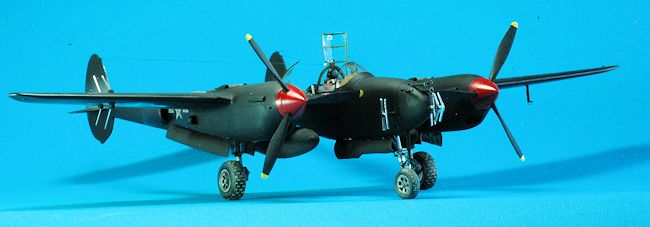 e
placement, Note my model is based on this photograph but I could not find this
stencil appearance on the other photos so don’t send me any “you made a mistake”
messages regarding the prop stencil, because I do know the P-38 prop stencil
goes the other way. Since there do not appear to be any stencil or Curtiss prop
logos in the other pictures I left them without any markings except for standard
yellow tips. The tires have block treads and spoke wheels on the main wheels.
There are no numbers or other designators on the fuselage based on these photos
which do show a complete side profile. Only the standard national markings
appear and they look to be black-washed to lessen night visibility.
e
placement, Note my model is based on this photograph but I could not find this
stencil appearance on the other photos so don’t send me any “you made a mistake”
messages regarding the prop stencil, because I do know the P-38 prop stencil
goes the other way. Since there do not appear to be any stencil or Curtiss prop
logos in the other pictures I left them without any markings except for standard
yellow tips. The tires have block treads and spoke wheels on the main wheels.
There are no numbers or other designators on the fuselage based on these photos
which do show a complete side profile. Only the standard national markings
appear and they look to be black-washed to lessen night visibility.
One of the best references I used for general P-38 detailing was The Modeler's Guide to the P-38 Lightning by Jay Sherlock. On page 60-61 it lists all the changes required to build an accurate P-38F and on pages 62-63 all the modifications for the P-38G are listed. It mentions the existence of this YAGI field modification. It is my “go-to” reference for building any P-38. When modeling, and as a general rule, I try to get good reference photos of my subject and don’t generalize. There were conflicting details on whether the Yagi Radar aircraft was a single pilot with no radar operator or a two man aircraft. Since the Queen of the Midnight Skies text was so well done with deep research I decided to use its descriptions alluding to a two manned version of the P-38G as the basis for my model.
A multi-part series of Wings magazine articles were written by Warren Bodie prior to his release of his fantastic book "The Lockheed P-38 Lightning - The Definitive Story of Lockheed’s P-38 Fighter" in 1991. A half-page sized photo on page 112 of the actual aircraft states "two radar equipped P-38F's fought the Japanese in the Pacific at Guadalcanal..." Two amazing photos of the P-38F/G Night fighter Field Mod are found in Wings Magazine Volume 8 #4, August 1978, on page 70 with the caption note “6” and “7”. It clearly shows the Yagi radar array taken from the P-70. It is in overall black paint with a light gray or possibly white or yellow prop spinners. There is a complete standard P-38 gun array with four browning .50 caliber machine guns and one 20mm cannon. It is hard to tell if there is some form of flash hider on the gun muzzles. The drop tanks were present and painted overall flat black. The aircraft had spoke (not covered) main wheels. The front wheel also had block treads. There appears to be a white tail number but it is obscured. From what is visible it looks like white “51”. The narrative calls out the aircraft as P-38F’s which since the “F” & “G” have no discernable external differences is not a concern for my build just a concern for accuracy in text. The Wings magazine photos could have been photos taken just after construction was completed and before the aircraft were painted in their final overall black paint. That means I could someday re-do this project using the standard upper olive drab over a neutral gray color scheme and yellow prop hubs!
| CONSTRUCTION |
Construction was very straightforward using the sequence in the kit
instructions. The cockpit, wheel wells and engine booms were painted and
assembled. I initially was going to use the Aires P-38 resin cockpit in this
build. I have used most of the aftermarket P-38 resin cockpit sets and like the
crisper and more accurate detail of the Aires set. Then, when I started to plan
out the cockpit conversion details I realized I would have to remove the rear
radio area of the Aires resin cockpit to create a radar operator (R/O) space.
No, I don’t want to damage such a fine resin component so it was returned to the
stash. I 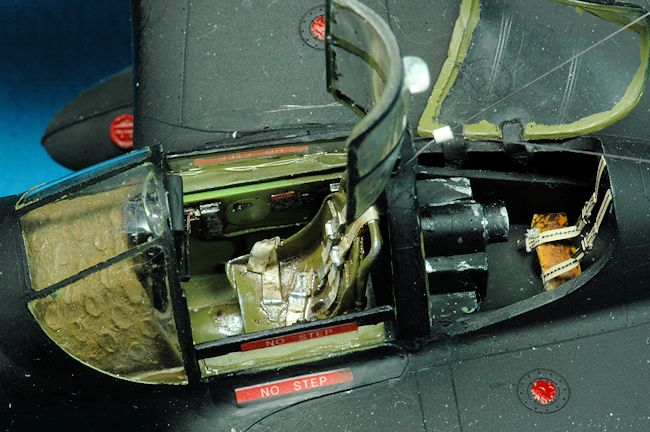 then
decided to use the Hasegawa kit plastic and perform the required cuts and
adaptations to that instead. I added an Ultracast # 48223 P-38 Lightning Seat
with harness and some Eduard etched details to the kit plastic. I was pleased
with this cockpit approach.
then
decided to use the Hasegawa kit plastic and perform the required cuts and
adaptations to that instead. I added an Ultracast # 48223 P-38 Lightning Seat
with harness and some Eduard etched details to the kit plastic. I was pleased
with this cockpit approach.
From the venerable Monogram 1/48th P-38 a radar set, part # B91, was used for the R/O. It looks much like the SCR-540 components so it worked for me. Since the reference texts refer to the R/O using a “bench” seat I scratch built one from plastic card and added an Eduard harness and lap belt. The rear canopy was cut to provide a frame to attach the pilot area top canopy with the later rear opening top hatch found on P-38G’s. The rest of the rear canopy was used to provide entry and egress for the R/O also using a side mounted opening with a scratch built hinge to form a fuselage to rear canopy join.
I added some Eduard mesh screens to the oil cooler and radiator inlets and outlets. There were large gaps at the join area between each engine boom and the wing. I filled the gaps with Tamiya putty and some CA glue, then restored the lost detail by re-scribing. The only other significant problem I have had with Hasegawa’s P-38’s is a difficult time attaching the main landing gear doors. Part of the problem is caused by the imperfect fit of the main gear wells. They come in multiple parts making it easy to paint and detail but onerous to assemble and fit into the boom. I would prefer to have Hasegawa provide this as one unit. I have not seen any resin replacements for the gear wells so I go with what I have. Also, there is no hydraulic actuator which could have helped in holding the doors in the correct position. The nose gear well and door was not a problem to assemble and attach. The nose gear well does have its hydraulic actuator.
The SCR-540 1.5m Radar was the American version of the British Mk. IV Radar, manufactured by Western Electric. It was delivered in 1942 for installation in the USAAF P-70 and USMC PV-1 night fighters. It used multiple antennas : a fixed quarter wave dipole with directors on the side of the fuselage (azimuth receiving antenna); two sets of fixed quarter wave rods, one set above and one set below the left (port) wing (elevation receiving) on the P-70 ; and a nose 1.5M wave transmitting antenna.
The Yagi antenna used in my conversion came from an AMT/ERTL 1/48 Douglas P-70 Night Fighter, kit number 8646, released in 1997. I planned to use it as a template and replace the antenna pole components with guitar string wire but the size of the bends were too small for my tools. There are no cockpit oriented night fighter R/O or otherwise components in the P-70 kit. The kit is missing the upper and lower wing antennas. Parts tree ”F” has all the P-70 changes this kit provides which is a new nose, and nose tip & side Yagi radar antennas with a belly gun pack. Taking the parts from this kit left me with a nice A/B-20 kit for a future build.
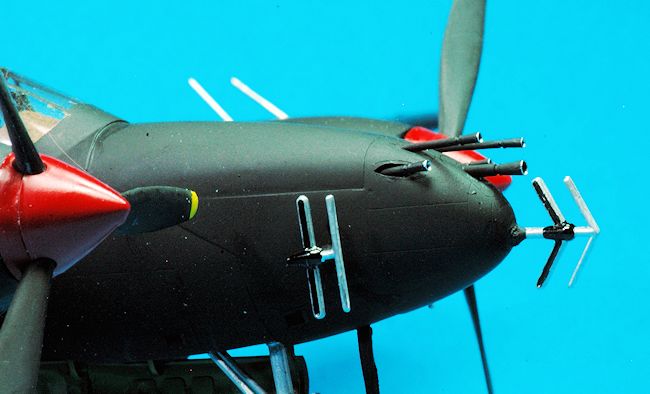 The term “Yagi”
from a Wikipedia explanation is for an antenna sometimes called the “Yagi-Uda
antenna, commonly known simply as a Yagi antenna, is a directional antenna
consisting of multiple parallel dipole elements in a line.“ It is usually made
of metal rods and consists of a single driven element connected to the
transmitter or receiver with a transmission line, and additional parasitic
elements: a so-called reflector and one or more directors. “The reflector
element is slightly longer than the driven dipole, whereas the directors are a
little shorter. This design achieves a very substantial increase in the
antenna's directionality and gain compared to a simple dipole. The antenna was
invented in 1926 by Shintaro Uda of Tohoku Imperial University, Japan, with a
lesser role played by his colleague Hidetsugu Yagi. However the "Yagi" name has
become more familiar with the name of Uda often omitted. This appears to have
been due to Yagi filing a patent on the idea in Japan without Uda's name in it,
and later transferring the patent to the Marconi Company in the UK. Yagi
antennas were first widely used during World War II in radar systems by the
British, US and Germans. After the war they saw extensive development as home
television antennas.”
The term “Yagi”
from a Wikipedia explanation is for an antenna sometimes called the “Yagi-Uda
antenna, commonly known simply as a Yagi antenna, is a directional antenna
consisting of multiple parallel dipole elements in a line.“ It is usually made
of metal rods and consists of a single driven element connected to the
transmitter or receiver with a transmission line, and additional parasitic
elements: a so-called reflector and one or more directors. “The reflector
element is slightly longer than the driven dipole, whereas the directors are a
little shorter. This design achieves a very substantial increase in the
antenna's directionality and gain compared to a simple dipole. The antenna was
invented in 1926 by Shintaro Uda of Tohoku Imperial University, Japan, with a
lesser role played by his colleague Hidetsugu Yagi. However the "Yagi" name has
become more familiar with the name of Uda often omitted. This appears to have
been due to Yagi filing a patent on the idea in Japan without Uda's name in it,
and later transferring the patent to the Marconi Company in the UK. Yagi
antennas were first widely used during World War II in radar systems by the
British, US and Germans. After the war they saw extensive development as home
television antennas.”
The Yagi setup on my P-38G consisted of three antenna arrays. The first is the Nose Transmitting Antenna taken from the AMT P-70 kit. The second set of antennas are the Azimuth Receiving Antennas found on both forward sides of the aircraft’s nose also from the AMT P-70 kit. The final set of antennas are the elevation receiving rods, consisting of a rod and a flat blade antenna found on both the top and bottom of the port or left wing. It is missing from the AMT P-70 kit and was scratch built from metal rod guitar wire) and shaped plastic sprue for the base antenna mounting teardrops.
For the rear R/O compartment I used the radar boxes found in the Monogram P-38 Lightning kit. They represent the SCR-520B used in the P-70. They provided the five parts needed: (1) Indicator with a view screen painted chrome silver with a clear orange yellow paint overlay to simulate the actual screen. (2) inverter box (3) synchronizer (4) beacon synchronizer and (5) power distribution box. A plain wooden bench seat with a shoulder harness was provided for the R/O in the back office.
| COLORS & MARKINGS |
I used
Tamiya flat black overall since the decals were minimal it did not require a
gloss surface. I also went with a flat rather than shiny black because the
written accounts said it was flat black. The harsh sun
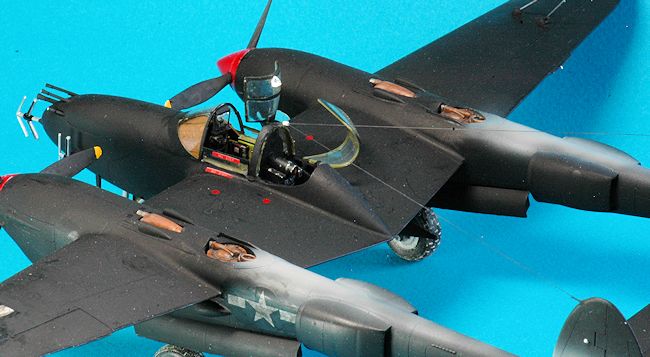 of the
South Pacific would soon deteriorate shiny black paint as well. I first painted
the cockpit with Gunze Aqueous H58 Interior Green followed by Testors metallic
and Tamiya final touches. An artist’s oil burnt umber wash was applied to the
Ultracast seat and cockpit interior.
of the
South Pacific would soon deteriorate shiny black paint as well. I first painted
the cockpit with Gunze Aqueous H58 Interior Green followed by Testors metallic
and Tamiya final touches. An artist’s oil burnt umber wash was applied to the
Ultracast seat and cockpit interior.
The P-38 and especially well used versions all had extensive exhaust stains. I used Tamiya flat white and Tamiya gray paints to simulate the exhausts. I normally use buff as well for this step but I felt the exhaust discoloration on flat black would be more accurate in a white & gray combination. The exhaust stains run down the tail booms and goes through the vertical tails scorching the underlying paint. Due to the harsh conditions in the South Pacific where this aircraft operated I weathered the airframe to reflect these hash conditions using some layered lightened paints with pastel chalks. MIG pigments P030 Beach sand was used to simulate sandy conditions in the S.W.P. where this aircraft operated. I did not use any Testors Dullcote or flat clear as I normally would.
| CONCLUSIONS |
I have built and also converted
several Hasegawa 1/48 P-38’s. Despite the extra work cleaning up seams and boom
alignment problems the finished model always makes me very pleased. With the
broad range of aftermarket decals, resin and photo etched parts there is no
limit to the level of detail you can add.
The kit in its plain OOB mode or with lots of aftermarket is sure to please most of us. I really like this kit and will build several more. This conversion into a field modified night fighter was a pleasant off-shoot from an F-4-1 photo recon search through my many books and magazines where I first noticed this rare, unusual but important aircraft in a few photographs. A P-38 in its F-4G photo recon bird feathers is next.
Highly recommended for the detailer is the Technical Order T.O. No. 01-75F-1 Section IV Operational Equipment for the P-38D & G, F-4 through F-5A photo-recon aircraft to confirm any details.
| REFERENCES |
The Lockheed P-38 Lightning by Warren Bodie Widewing Pubs 1991 photo on page 112
Queen of the Midnight Skies by Gerry R. Pape & Ronald C. Harrison Schiffer Books 1992
Wings Magazine, Vol. 8 No. 4, August 1978 for Yagi field mod photos and text.
Modelers’ Guide to the P-38 Lightning by Jay Sherlock
P-38 Walk Around # 5530 Squadron Signal Publications 2003 by Larry Davis
P-38 In Action # 1025 Squadron Signal Publications 1976
P-38 In Action # 1109 Squadron Signal Publications 1990 by Larry Davis
P-38 In Action # 1222 Squadron Signal Publications 2011 by David Doyle (many color photos)
P-38 Lightning Part 1 In Detail & Scale Vol. 57 by Bert Kinzey 1998
P-38 Lightning Part 2 In Detail & Scale Vol. 58 by Bert Kinzey1998
Technical Order T.O. No. 01-75F-1 Section IV Operational Equipment for P-38D through P-38G Series and F-4, F-4A and F-5A Series Airplanes
P-38 Lightning Production Line to Front Line # 3 Osprey Books 1999
Aero Detail 28, Lockheed P-38 Lightning Dainippon Kaiga Company, Ltd. 2000
September 2015
If you would like your product reviewed fairly and fairly quickly, please contact the editor or see other details in the Note to Contributors.